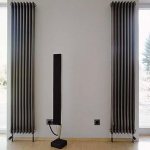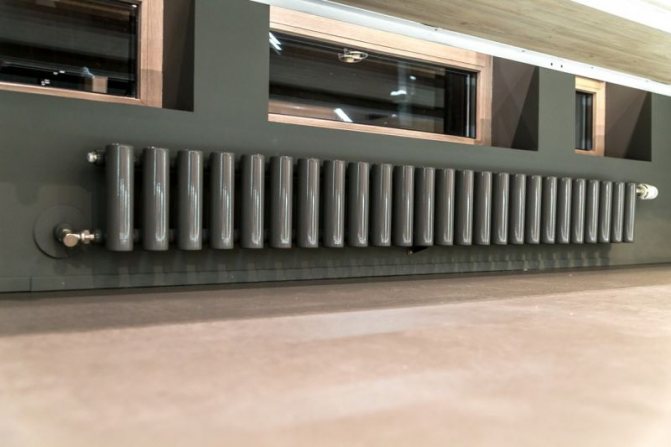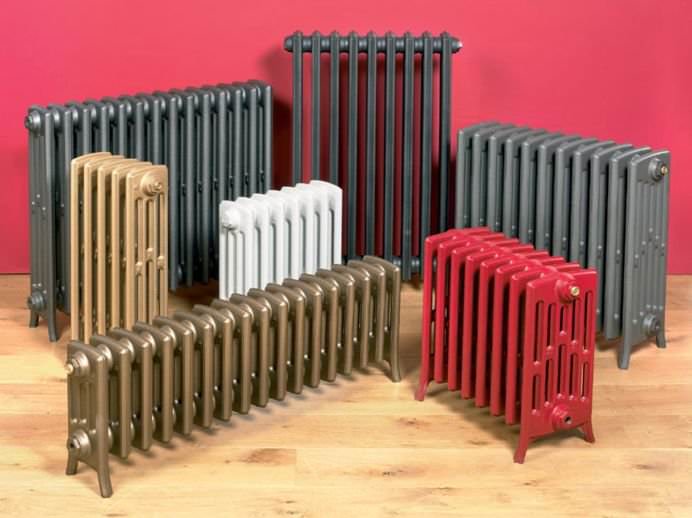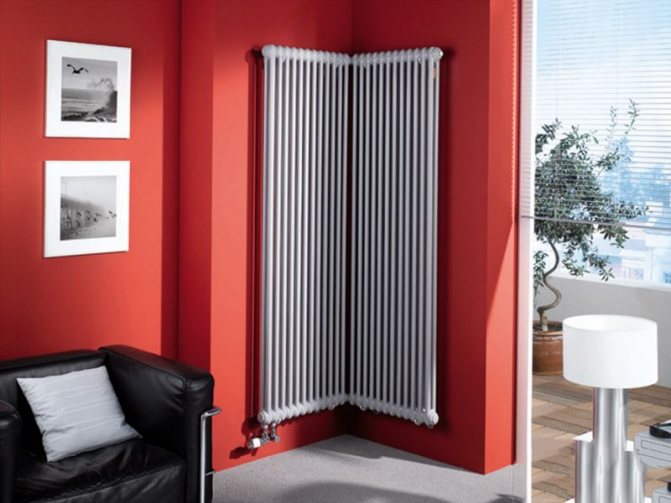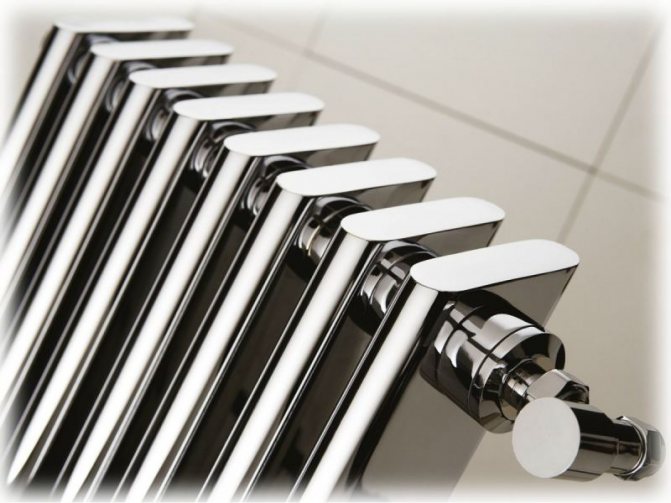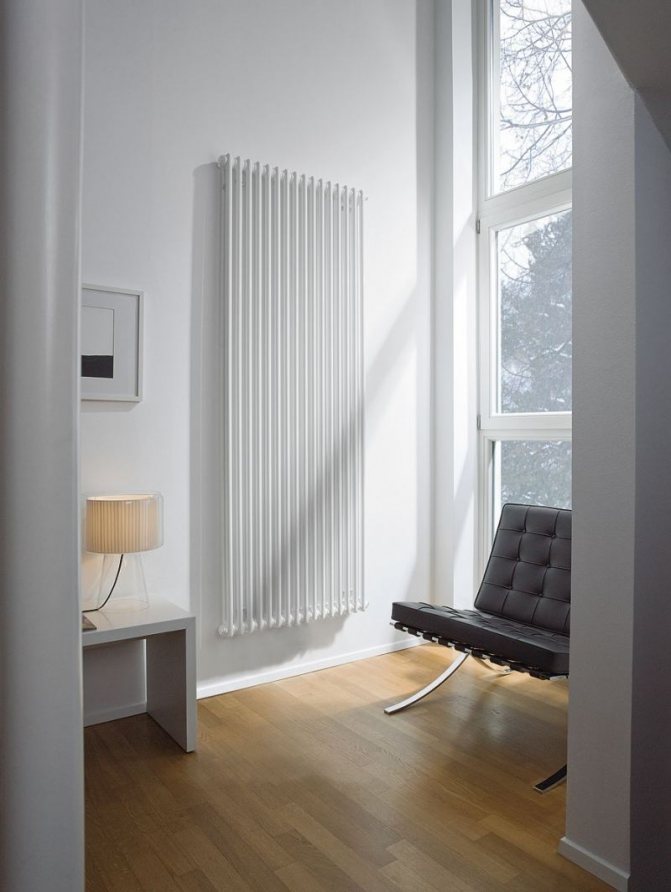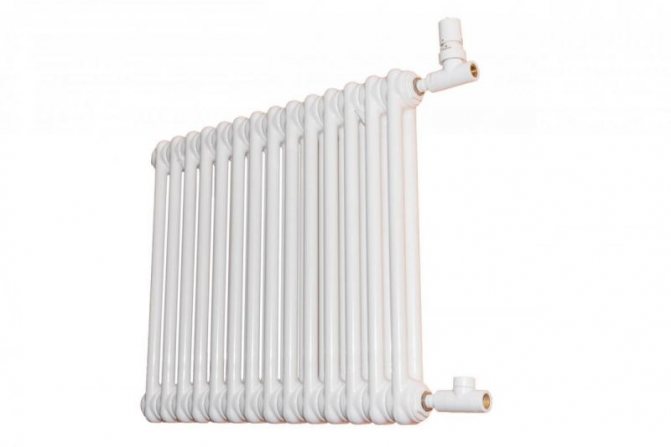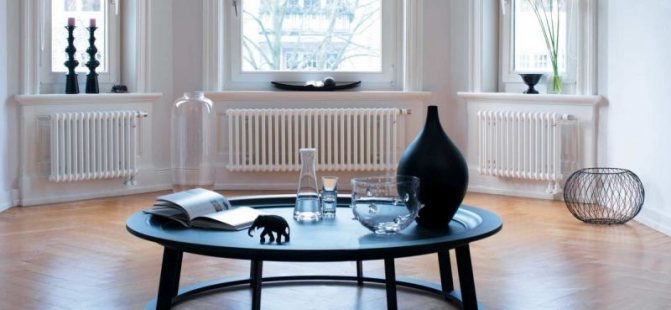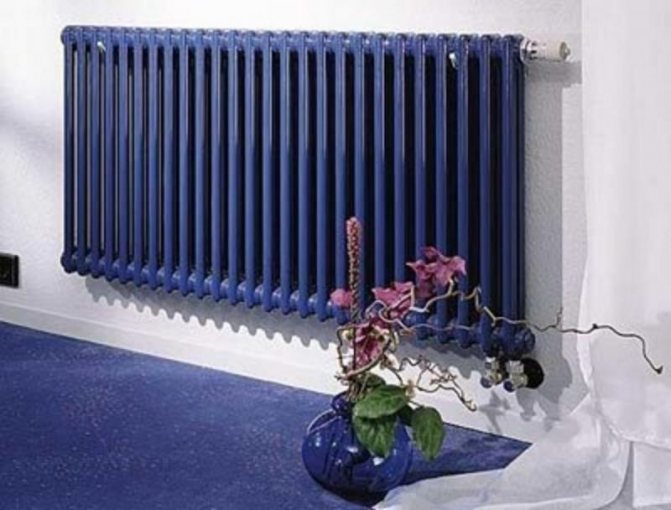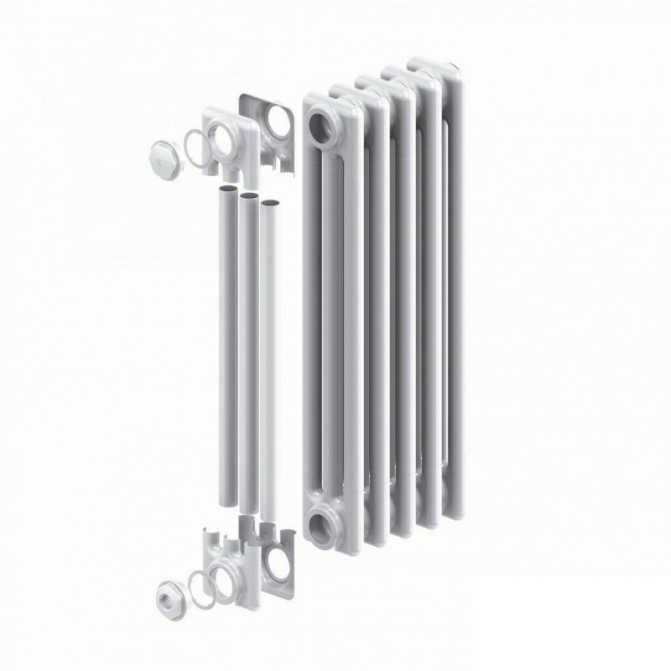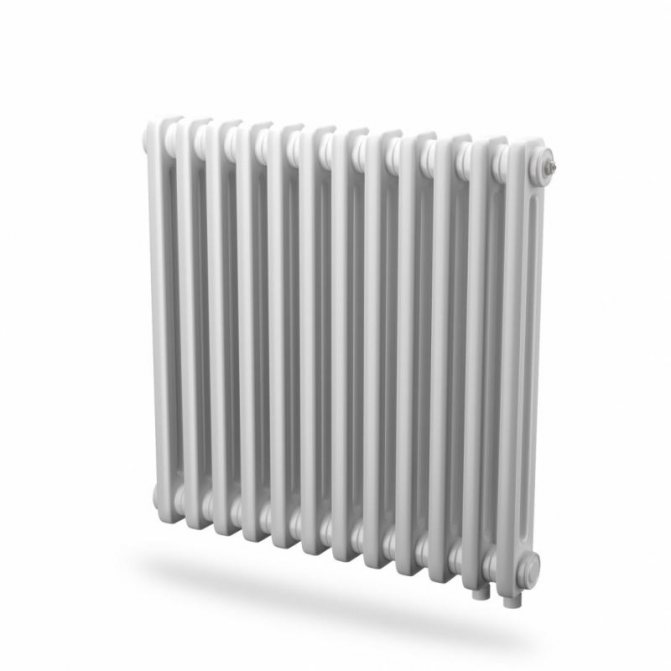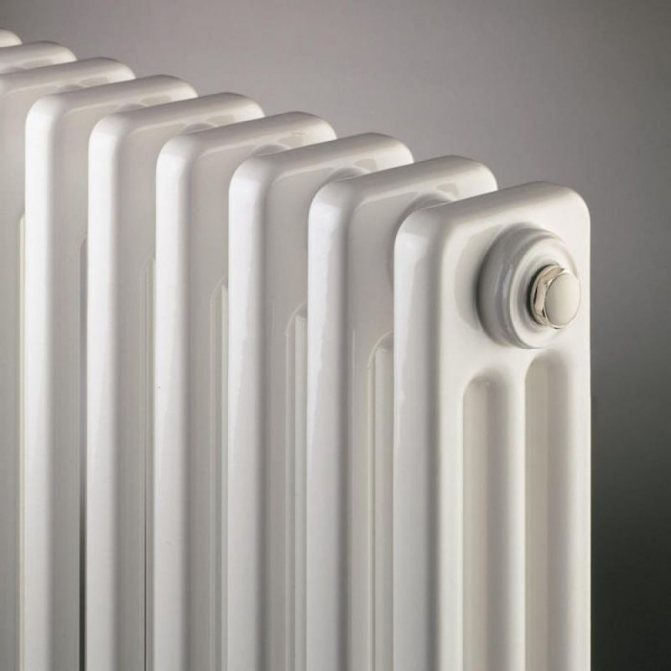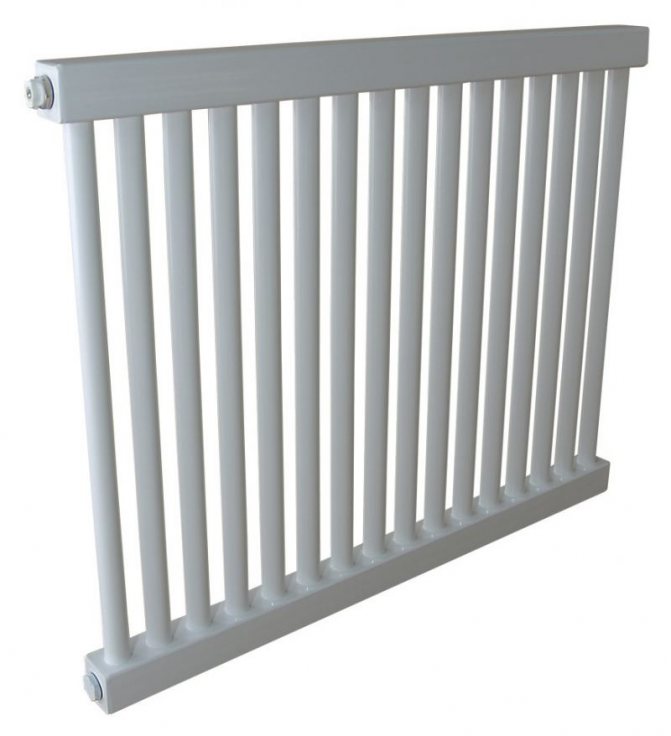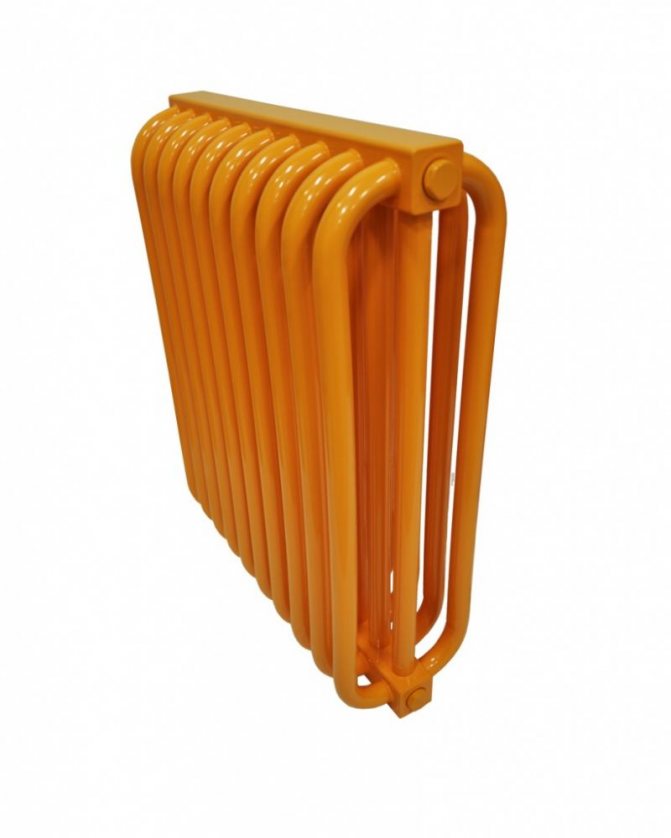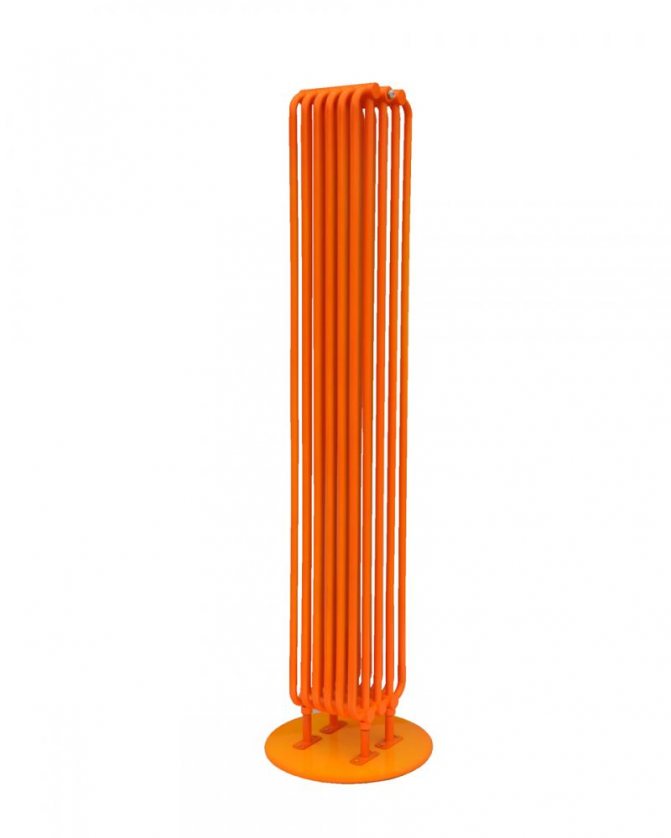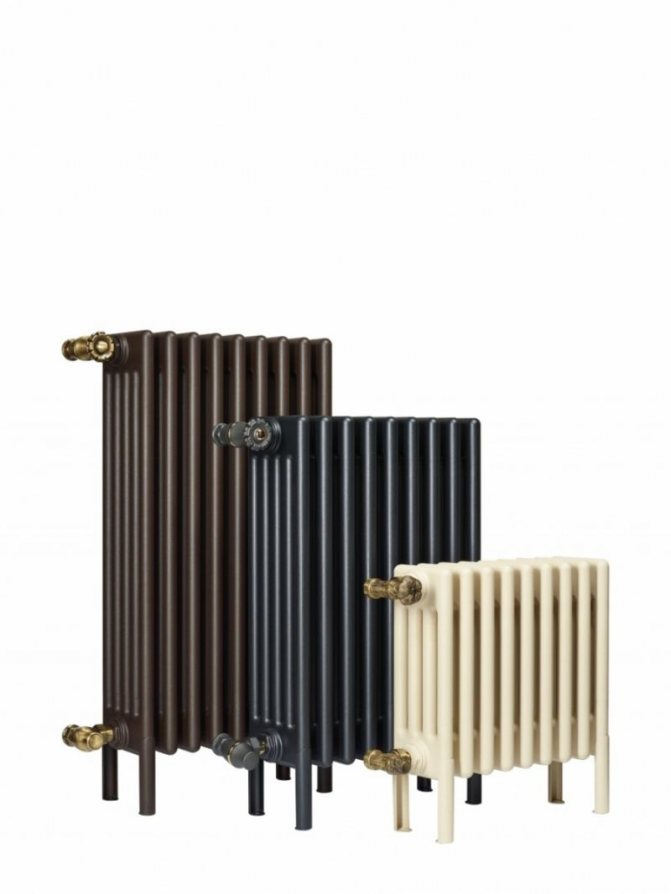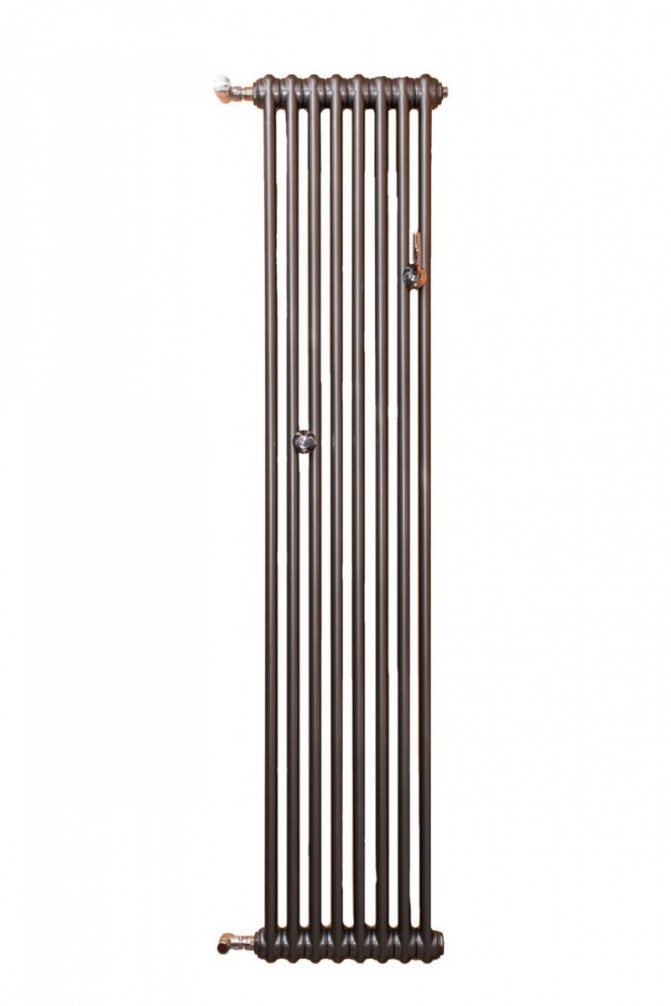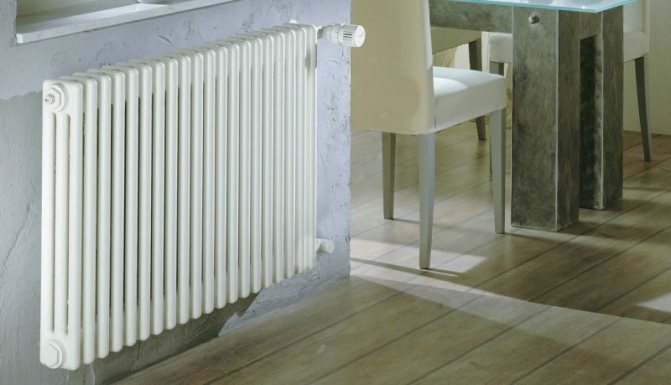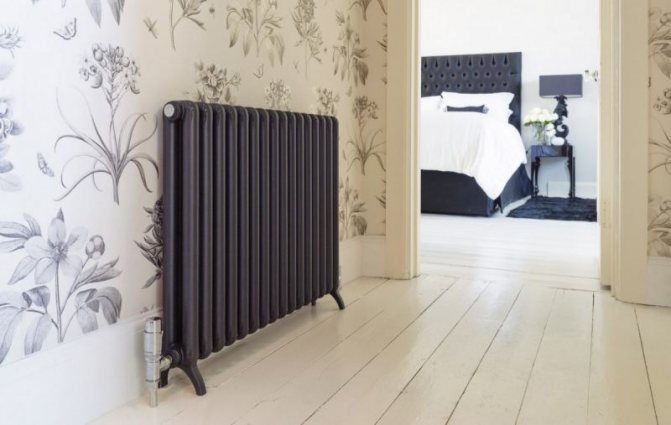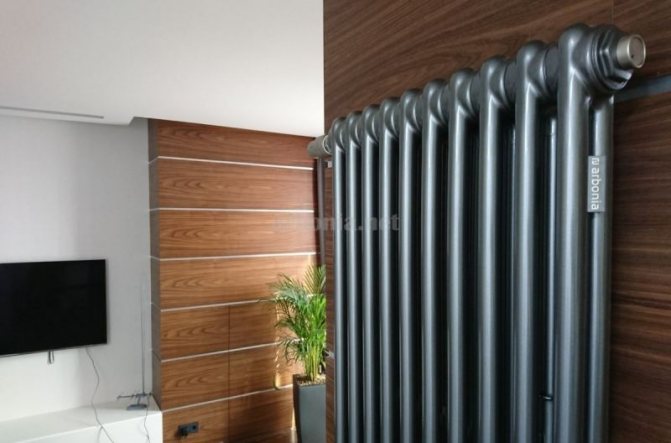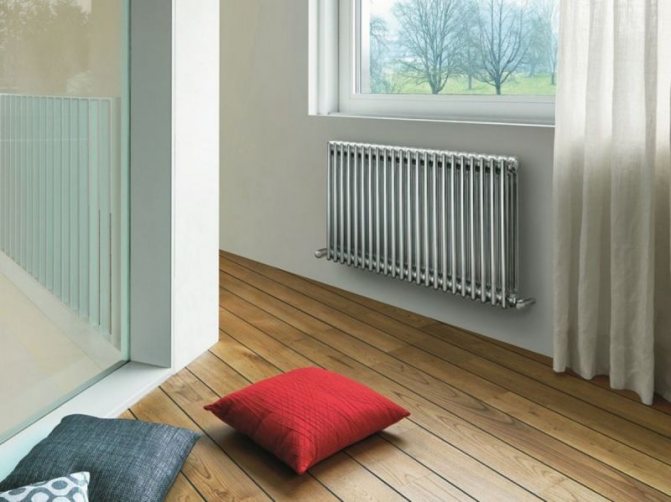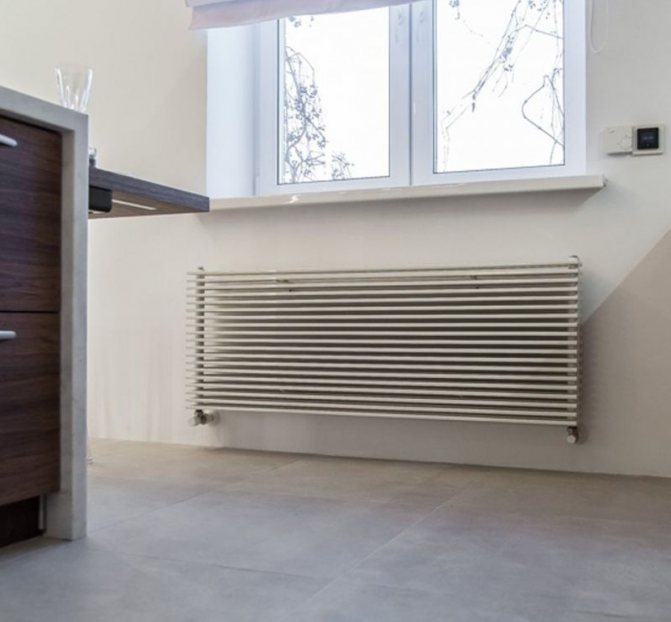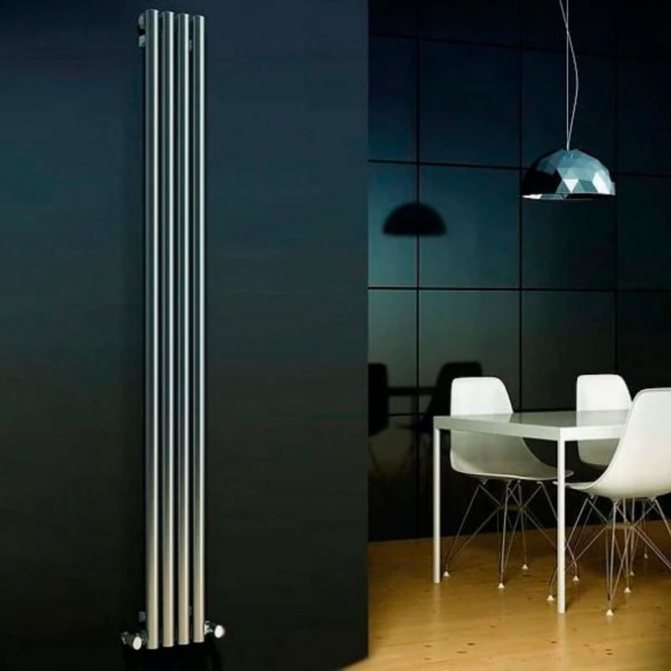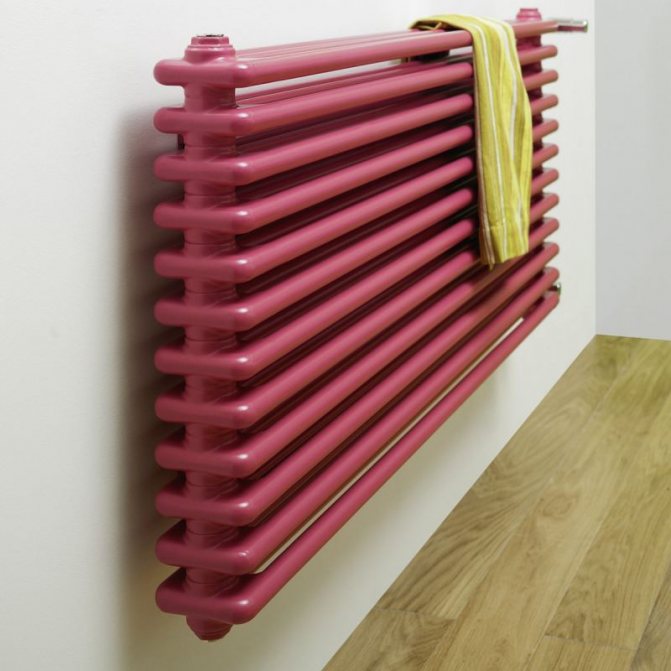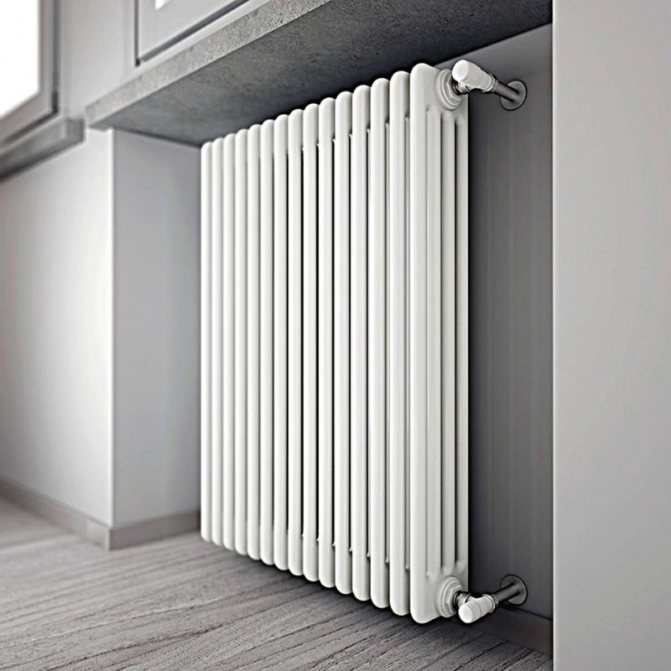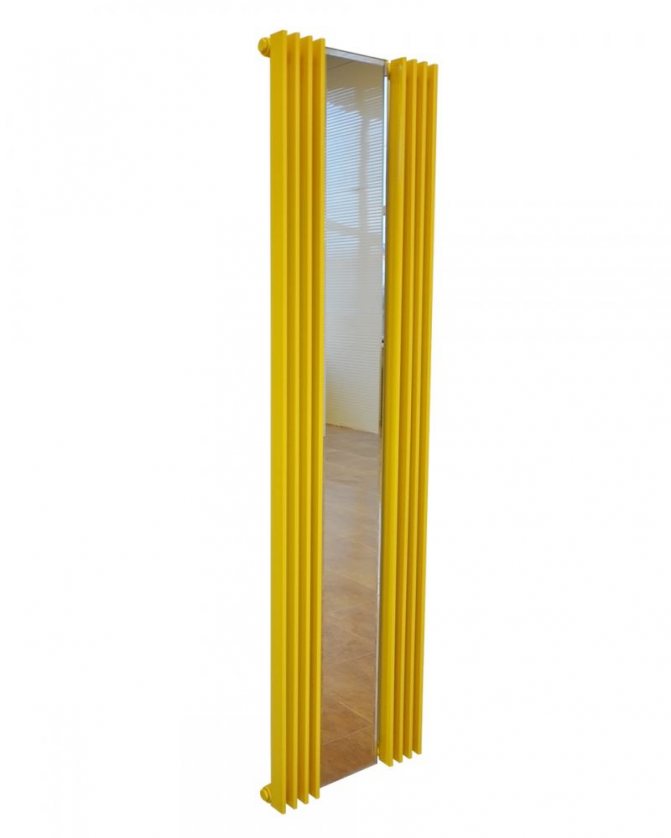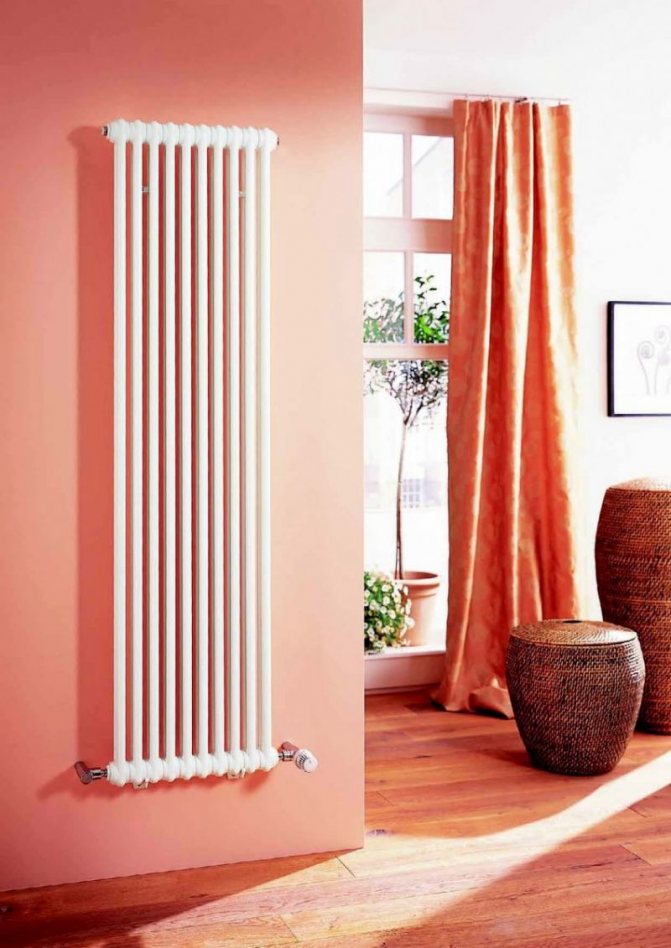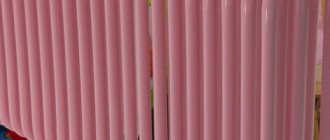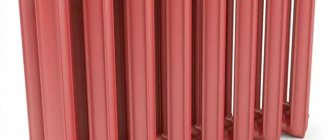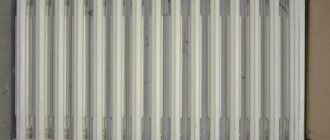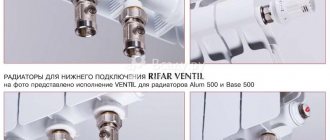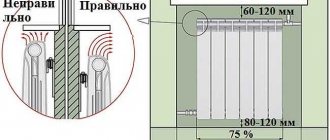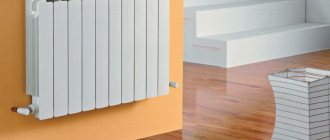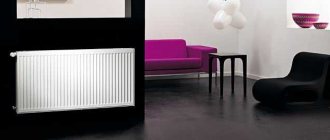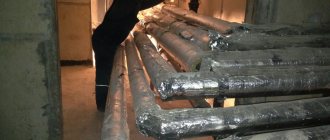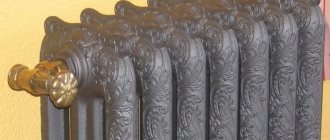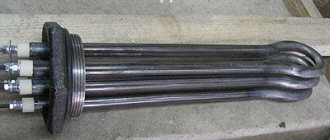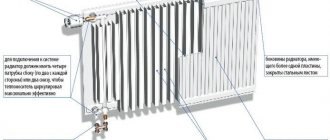Design features
The appearance of tubular batteries is slightly reminiscent of the design of cast iron radiators. The instruments include an upper and a lower collector, between which there are steel tubular bridges. To connect individual elements of the product, universal laser welding is used, which allows you to achieve accuracy and invisibility of the connecting seams.
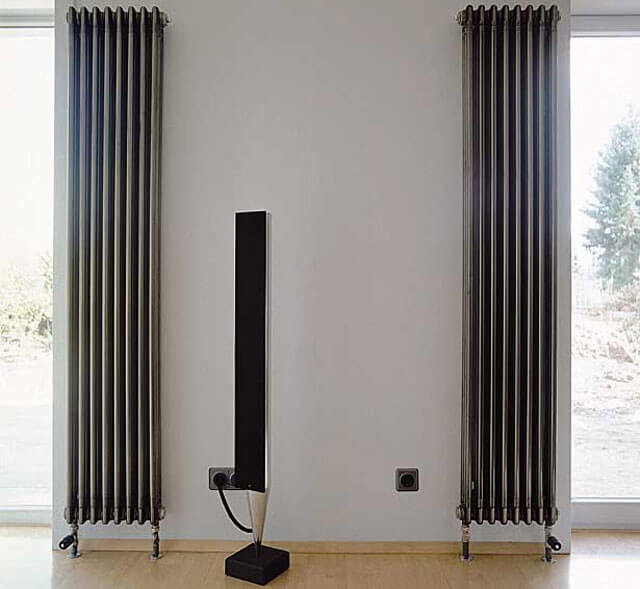
A distinctive feature of all tubular heating radiators is their strength. On sale, they are presented in a significant variety in shape, size and color design: this greatly simplifies the selection of the most suitable heating device for the interior of a particular room.
Advantages and disadvantages of tubular radiators
Advantages of tubular radiators:
- The tubular structure makes them resistant to pressure drops in the heating network, and with a sharp cut-off of heat, the radiator will not be airy.
- On tubular radiators dust does not accumulate, but smoothly descends down smooth steel pipes.
- Steel radiators have smooth walls pipes inside and outside, giving the radiator itself an attractive appearance. If you wish, you can even make a custom-made tubular radiator according to your sketch.
- Unlike panel radiators, tubular can take any form, and unlike cast-iron "accordions" they have no ribbing, so their surface is easy to clean.
- Unlike aluminum batteries, steel radiators have quality welded jointswhich prevents water leakage.
The most reliable radiators are considered, in which laser welded work was used.
disadvantages:
- Heat dissipation of tubular radiators slightly inferior oil heating radiators.
- Metal exposure corrosion, but in a private house, antifreeze or other non-aggressive liquid can be used as a coolant, while in city apartments, except water nothing can be used. And even then the water used in the city water supply system has various impurities and additives, which further enhances corrosion.
- High price. But their service life can reach 25 years, so all costs are paid off during operation.
Optimal installation location
With the help of steel tubular radiators, it is generally customary to equip heating systems with private houses and five-story buildings. High-rise buildings are an unsuitable place for their installation due to frequent water hammering: given that the working pressure of a steel tubular battery is only 6-10 atmospheres, this is fraught with serious consequences.
Any serious pressure surge in the system can cause leakage and damage to the device. Autonomous heating systems are characterized by a lower level of operating pressure - no more than 8 atmospheres. This makes it possible for the tubular radiator to comfortably transfer all overloads inside the circuit.
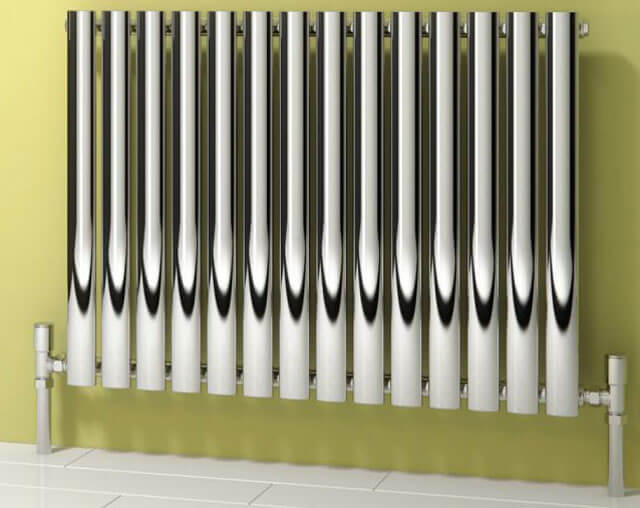

Quite often, medical institutions are equipped with such devices: this is facilitated by the high hygienic characteristics of batteries and a low level of trauma. There are no sharp corners on the products, all bends are smooth and smooth here. In addition, steel tubular radiators are an order of magnitude more durable than their cast-iron counterparts.
Installation
The installation of steel tubular batteries is in many ways similar to the installation of traditional models and not very difficult with theoretical knowledge and practical skills.
List of tools required for work:
- screwdriver;
- hammer drill or hammer drill;
- adjustable wrench;
- pliers;
- roulette;
- building level;
- pencil.
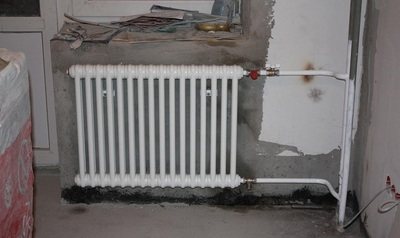

Installation steps:
- Dismantling the old battery.
- Layout and installation of mounting brackets. Steel tubular radiators are heavy, therefore it is necessary to use brackets with the appropriate load capacity.
- Tubular radiator canopy and mounting kit assembly.
- Installation of a shut-off valve, a valve under a thermal head and a Mayevsky valve.
- Connection to pipes of the heating system.
- Crimping.
Connection method
Most models are connected to the heating system bottom or side way... The choice of the connection method is influenced by the characteristics and features of a particular model, as well as the features of the distribution of heating pipes in the premises.
Bottom connection method consists in the fact that both the supply and return pipes are connected to the radiator from below. With side connection supply and return pipes are connected to the left or right side of the battery, depending on the model.
Conditions for correct installation
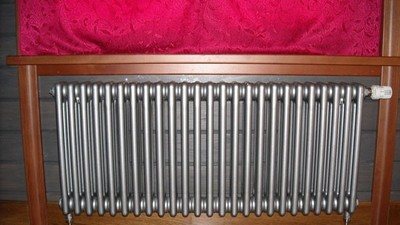

Regardless of the characteristics of the radiator, for its efficient operation during installation, it is important to ensure the following conditions:
- Distance between the top edge and the window sill (for horizontal models): 5-10 cm.
- Distance between bottom edge and floor: 9-12 cm.
- Distance between wall and radiator: 2-5 cm... If installing a reflective thermal insulation layer, longer mounting brackets will be required.
Characteristics of tubular heating batteries
The material for the manufacture of tubular radiators is most often steel, which gives them special strength and reliability.
Main technical parameters of tubular steel radiator:
- Height... It can be from 30 to 300 cm.
- Number of pipes... There are no restrictions here: there are models with one tube, and there are models with a much larger number of jumpers.
- Depth... Approx. 225 mm. One row can contain 1 - 6 elements. The formation of the cost of the device is influenced by the working volume and parameters of the jumpers.
- Sectional Distance... There are two options: 65 and 45 mm. Radiators with a section pitch of 65 mm are mainly used in hospitals, schools and other institutions where there are very high hygienic requirements.
- Wall thickness... It can be from 1 to 2 mm. For Western products, a thickness of 1-1.5 mm is characteristic. For domestic devices, it is slightly larger - 2 mm.
- Section section... The standard version is round tubes with a diameter of about 25 mm. Less commonly, you can find products with flat, rectangular, oval and triangular sections.
Construction of tubular heating radiators
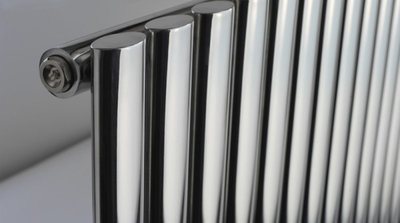

The appearance of tubular radiators as a whole differs little from traditional batteries of heating systems, but at the same time they are sleeker and thinner.
One of the main differences is that tubular batteries are not monolithic, they consist of separate elements pre-welded into a single unit.
Tubular radiator design includes the following elements:
- Upper manifold.
- Lower collector.
- Steel tubesconnecting the collectors to each other.
- Fittings for connection to the heating system.
Depending on the specific model, one section contains from 2 to 6 tubes... In turn, number of sections fluctuates to the limit from 2 to 60. As the number of tubes increases, the depth of the battery itself increases, which makes it possible to reduce its width while maintaining optimal heat transfer rates. This factor is important for small rooms or rooms that do not allow the use of a battery of the required width.
Reference. Wide range of commercially available models allows you to make the best choice taking into account the characteristics and characteristics of the premises that need to be heated.
Tubular battery cells made of steel, primarily due to the high strength, ductility, weldability, as well as the resistance of this alloy to corrosion processes. Separate elements are connected by laser welding, which provides a minimum thickness of welded seams with high strength and reliability of the finished structure.
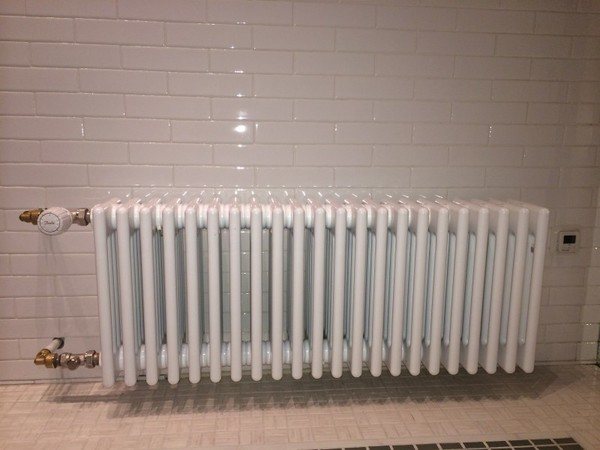

Photo 1. Tubular radiator of vertical type. Made of steel, has a large number of tubes.
Key Features
In addition to design features, such heating equipment is also characterized by:
- Connection variability... Due to the presence of a pair of lateral and a pair of lower fittings, the devices are connected to the heat supply system in a lateral or lower way.
- Installation variability... A number of models are equipped with feet, which allows placing batteries on the floor without fixing to a wall.
- Reduced hydraulic resistance provides good throughput during operation.
Specifications
Depending on the specific model, the main technical characteristics of the described units vary within the following limits:
- Height — from 150 to 3 thousand mm.
- Width — from 200 to 2 thousand mm.
- Depth — from 50 to 300 mm.
- Wall thickness — from 1.2 to 2 mm.
- Operating pressure — up to 10 atm.
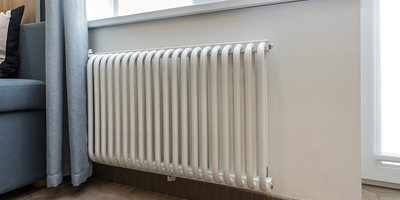

And also vary from model to model:
- Number of sections... The width of the radiator directly depends on this parameter.
- The number of tubes in a section. Affects the depth of the battery.
- Tube section... Among the models available on the market, the most common batteries are with round, rectangular and oval sections of the main structural elements.
Important! Battery tube cross-section practically does not affect its heat transfer rates and has a decorative rather than a practical function. The efficiency of work primarily depends on the diameter of the tubes and their number in the section.
Advantages and disadvantages
Among the undeniable advantages steel tubular batteries stand out:
- Ease of installation, opportunity self-installation.
- Heating uniformity.
- Safety of use and long term of effective operation.
- In most models no sharp corners, which greatly minimizes the likelihood of injury (especially by young children).
- Ease of service and maintenance.
- Variety of lineup allows you to select a radiator that matches the interior of the heated room.
The main limitations:
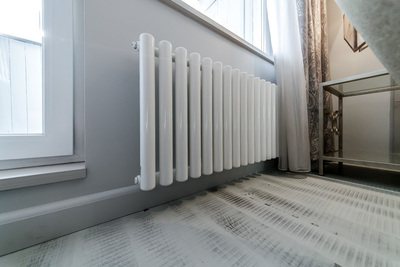

- Low heat transfer rates. Moreover, this disadvantage is primarily inherent in the cheapest models with a minimum number of pipes in the section.
- High price compared to traditional radiators.
- Risk of breakthrough at welding points at high pressure drop.
The above factor is largely limits the range of effective and safe use similar devices.
Sharp pressure drops are predominantly characteristic of centralized heating systems in apartment buildings, which is why experts recommend installing tubular radiators only in private dwellings equipped with autonomous heating systems.
Attention! The effective and safe use of tubular radiators depends on quality of installed equipment, as well as adherence to recommendations, given in the operating instructions.
Main varieties
Horizontal and vertical steel radiators are distinguished by the type of tube arrangement. Large offices and halls are usually equipped with horizontal appliances. The scope of vertical tubular batteries is in private homes, hospitals and schools. The design features of vertical models contributes to a visual increase in the height of the premises. In addition, they hardly accumulate dust.
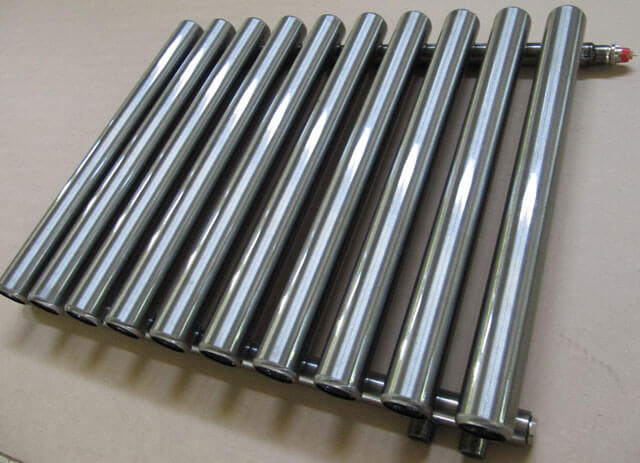

The shape of this type of heating devices can be angular, flat, radius and design. In corner models, two sections are used, which are located at a certain angle to each other. In this case, it is possible to adjust the angle, depending on the characteristics of the interior. Flat models are characterized by a single-row arrangement of tubes: this form of the device is the most popular among buyers. The radial configuration assumes the presence of an arc. Designer models are designed with special originality. One option is to bend the vertical tubes to create a wavy effect.
Features of the model
Not so long ago, only cast iron batteries were used in the heating system. They were reliable, people trusted them and did not look for any other options. The new generation batteries have supplanted their rivals with a beautiful design. Carrying out repairs in European-style apartments, the owners want to see under the window something beautiful, of a peculiar shape, not standard, something that will delight the eye and please the guests. Tubular radiators allow them to respond to their tastes.
Heating radiators are available in different colors and shades, different sizes and shapes. Their design will fit into any room. In addition, this type of battery belongs to the highest class among room heating devices. The features of the model are high technical characteristics of tubular radiators, horizontal and vertical position, the ability to place them along the entire height of the wall, since they can reach three meters in height.
In one slab, the number of tubes can be very different: one or ten, it all depends on the wishes of the customer or the wall where this structure will be located. The same thickness has no clear parameters. There is a possibility to change it. There are thin and thick radiators on the market. They are easy to clean, which speaks of their hygiene. They are safe, comfortable for buildings in which children are due to the lack of corners in them.
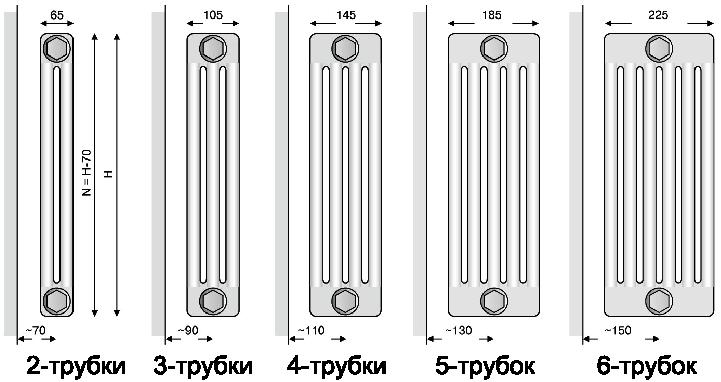

Number of tubes in a tubular radiator
Tubular heating radiators are mainly made of steel. Steel is reliable and durable. This is a metal that is not afraid of the aggression of the coolant.
Advantages and disadvantages
When considering a steel tubular radiator as a potential option for equipping your home, you need to become familiar with its strengths and weaknesses.
Advantages of tubular radiators:
- Resistant to increased water hardness... Corrosion is almost unknown to these batteries.
- A significant number of color and shape options... This makes it much easier to choose the most suitable option for the design of the room.
- Safety... There are no sharp corners on products of this type, which explains their popularity in families with small children.
- Easy to operate and maintain... The design of the tubular radiator does not contribute to the accumulation of dust. They are easy to clean and repair. Adjusting the water supply is very convenient here. If desired, the device can be placed under plasterboard sheathing.
- Convenience of commutation... Modern models allow both bottom and side connection.
- Reliability... For production, only modern materials and the latest technologies are used.
- The optimum ratio of price and quality.
Pros and cons of tubular batteries
Before you buy tubular heating radiators, you need to consider what advantages and disadvantages they have.
Among the advantages of using these heaters are:
- Resistant to the negative effects of hard water. Corrosion plaques are practically not formed on such batteries.
- Variety of colors and shapes. That allows you to choose a model that is ideal for the design of the room.
- Safety. The device has no sharp corners. A great option for families with children. Such radiators are less traumatic.
- Easy to operate and maintain.Due to their construction, the tubular batteries do not accumulate dust. It is very easy to wash them.
- Modern models can be connected both at the bottom and at the side.
- For production, only modern materials and the latest technologies are used.
Steel tubular heating radiators have very good reviews. Many users note the following advantages of tubular batteries: convenience in regulating the water supply, the ability to mount on drywall, the optimal price-quality ratio.
But heating devices have some disadvantages:
- Low power. Because of this, steel tubular batteries can only be installed in small buildings and private residential areas.
- The level of heat transfer is low.
- High cost. Since this type of heating devices appeared on the market relatively recently and new materials and technologies are used for its production, prices for steel tubular heating radiators are still quite high.
- Leaks may occur in areas where pipe welding has been carried out.
Decorative benefits
Tubular radiators are characterized by special grace and lightness. If desired, you can find models of non-standard configuration (semicircular sections, radiator benches, etc.), the cost of which is much higher. Especially worth noting is the wide range of colors of tubular steel appliances.
The most popular are light and dark solutions. Darker radiators have better heat dissipation. Bronze, metallic, lacquered wood, mother-of-pearl, aged bronze are considered more interesting color schemes. Good efficiency is observed in chrome-plated products.
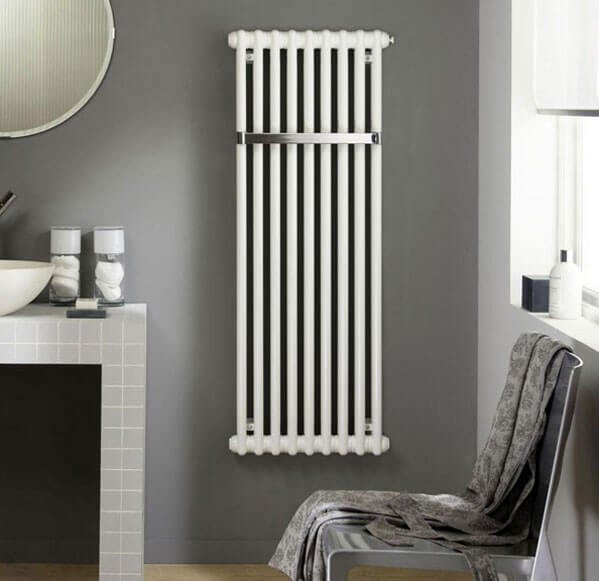

In such popular interior styles as vintage and loft, you can find more original design of heating devices. In some cases, special anti-corrosion agents are applied to the metal surface.
A transparent varnish is used here as a finish. An example of design is the use of grilles to make the radiator more aesthetically pleasing. In addition, this creates additional protection against mechanical stress. You can choose a mesh of almost any shade: the price remains stable.
Steel Tubular Radiator Market Overview
Tubular steel radiators are represented on the sanitary equipment market in a significant variety. Along with the standard designs, you can find real works of art. The same goes for the variety of manufacturing firms.
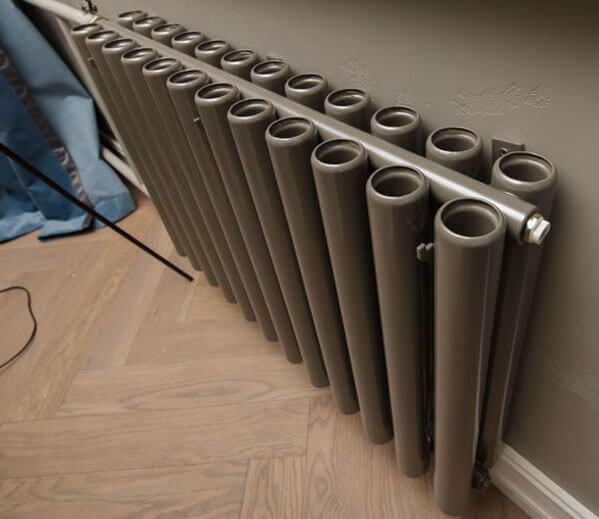

For our conditions, the most suitable option are radiators from domestic companies, in the manufacture of which the Russian climate, water characteristics, features of heating systems and other important parameters are taken into account. As for foreign products, German, Czech, Turkish, Polish and Italian models are of the highest quality.
Radiator mounting accessories
The most suitable method for installing heating batteries to the surface of the walls is selected taking into account their technical parameters - weight, dimensions - and also taking into account the place where they are supposed to be installed.
The most acceptable is the scheme where heating radiators are mounted under the windowsill, but there are situations when the installation of the heating device is required to be performed on the floor surface. Considering the method of fastening the heating battery, the type of necessary fasteners is selected. In the catalog of our online store, there is a wide selection of fastening systems and elements for various types of radiator installation.
To install the radiator, elements are used that correspond to the type of metal from which the heating device is made. Modern manufacturers produce radiators made of aluminum, cast iron or steel.Such radiators have good heat dissipation and a long service life.
Components for radiators and convectors in Moscow - Santekhkomplekt | Plumbing sale
Installation of radiators made of aluminum alloys is the easiest, since they have the least weight. For this purpose, brackets are used to install aluminum radiators. These brackets are manufactured in fixed lengths.
Installation of steel radiators is characterized by the fact that they must be fixed with a high degree of reliability, since with a large number of sections, they create a rather tangible load on the wall structure.
Cast iron radiators among all heating devices have the largest weight, therefore, special parts are used to mount them that can withstand sufficient weight without deformation. In addition, the fasteners for such radiators make it possible to adjust the distance between the battery and the wall.
Installation of a heating radiator to the floor surface can be associated with the structural or planning features of the building. Such fastening is also carried out in cases where the size of the windows is large enough, then the radiator is installed on a special pedestal or on the legs.
With this installation method, aluminum radiators are most often used. Since they are lightweight and look beautiful.
Turkish
They differ in quite good quality. At the same time, the assortment of Turkish steel batteries is distinguished by some scarcity of assortment. As a rule, these are panel radiators of a fairly inexpensive cost. Licensing of products is mainly carried out by well-known Western European firms, which allows you to be calm about their quality.
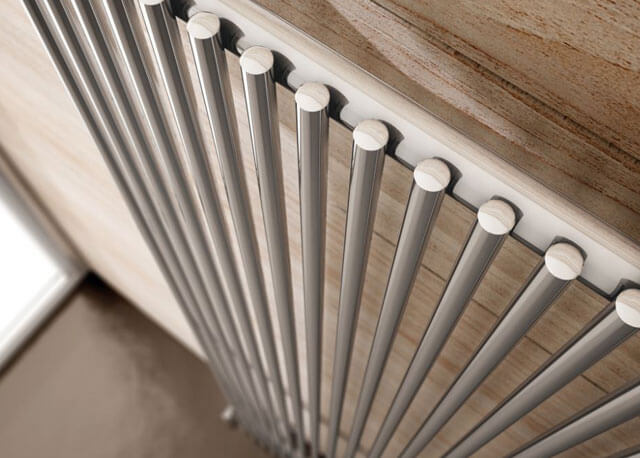

German
Especially worth noting is the high quality of the tubular steel radiators of the German company Zehnder. The products of this company are distinguished by a significant technological variety, with the ability to connect to hot water pipes, open hot water heating systems and electrical circuits. German plumbing firms specialize in non-standard heating devices. These models can be very tall or super low, with a very rich color gamut (700 shades). Consider the high cost of Zehnder products.
Speaking of German radiators, the Swiss-German company Arbonia is worth mentioning. These products are distinguished by their excellent design, high technical characteristics and quality. At the same time, the cost of Arbonia heating devices is quite acceptable for a domestic buyer.
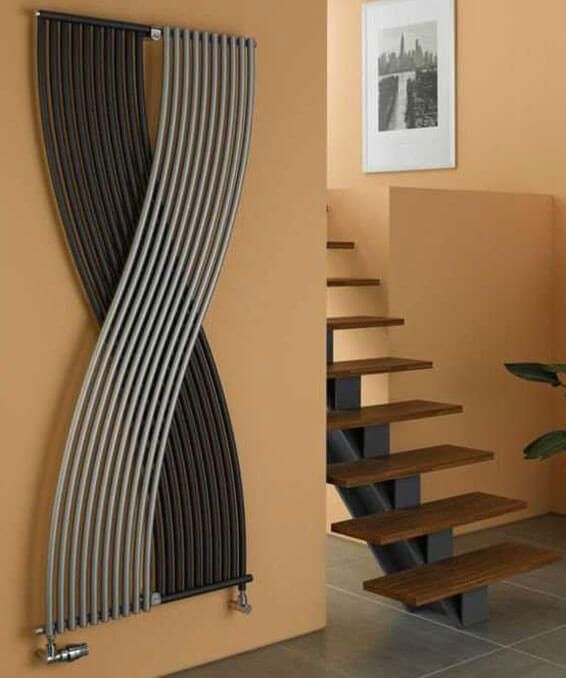

Our suggestions
If you are planning to buy components for radiators and convectors, you must remember that it is better not to save on such goods. Buying a high-quality radiator for heating and purchasing a poor-quality and unsuitable mount, you can thereby significantly reduce the service life of the entire heating system.
For certain types of heating radiators and convectors, you need to purchase a certain type of accessories.
If you have any doubts about the correct choice, you can call our specialists who will provide you with all possible assistance and advise on the correct choice of components. We guarantee the quality of the goods and their delivery to any place.
Italian
Italian radiators are characterized by a high level of quality and excellent decorative characteristics. At the same time, one should take into account their adaptation to European operating conditions, which differ from the realities in our country. However, high technical characteristics and convenient connections make Italian devices very popular. This is especially true of the products of the Royal company, which are distinguished by quality, ease of maintenance, reliability and durability. The cost of Royal radiators is quite high.
Chinese
The most budgetary model of a metal tubular radiator can be called the Chinese-made Oasis batteries. Despite its low cost, the device is distinguished by good durability, resistance to aggressive effects and the absence of operational restrictions. A number of models are manufactured taking into account the specifics of domestic heating networks. Tubular heating batteries Oasis have the most positive reviews. The company also specializes in the manufacture of standard bimetallic heating radiators with excellent thermal performance and affordable cost.

